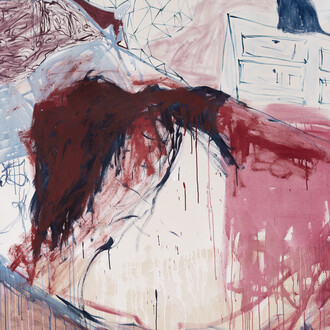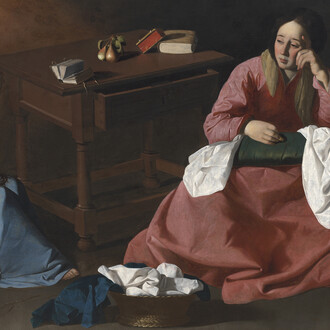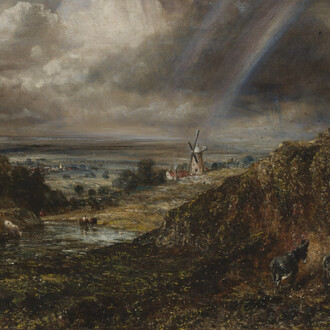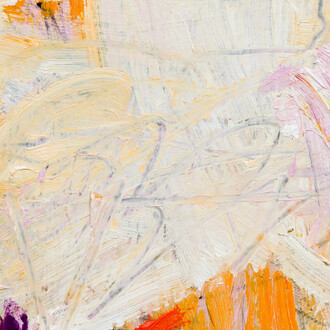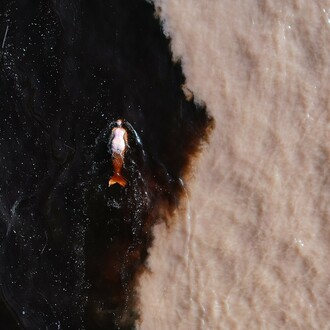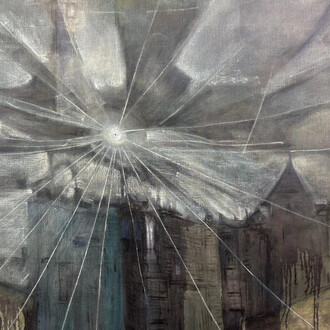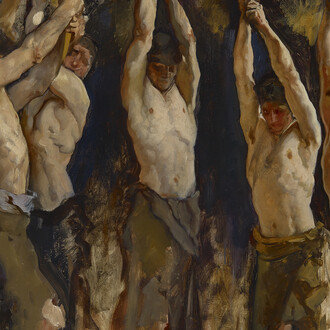Emalin is pleased to present a wound on my plate, Tolia Astakhishvili’s (b. 1974, Tbilisi, GE) first solo exhibition in the United Kingdom. Through a month-long engagement with The Clerk’s House, the artist has reshaped the gallery through architectural interventions, sculpture, painting, drawing, sound and moving image. The resulting exhibition comprises a body of new works alongside collaborations with Zurab Astakhishvili (1951 – 2025, Tbilisi, GE), Dylan Peirce (b. 1977, Paris, FR) and James Richards (b. 1983, Cardiff, UK).
Astakhishvili’s practice unfolds as a series of nested interiors, collaged worlds within worlds where multiple registers intersect. In this simultaneity, architecture becomes a structural material, responsive and unfixed, rewritten by the bodies and histories that move through it. Her interventions uncover hidden recesses, mapping the subtle remnants of use and care, while exposing the authority of existing structures and how they may be reorganized, concealed or sacrificed. Running through this process, Astakhishvili demonstrates an attentiveness to the human impulse to make and to discard. Domestic debris and disavowed objects, clutter estranged from its former use, are gathered and sorted into new arrangements.
In her hands, these objects, alongside raw construction material, drawings, writings, trompe-l’oeil painting, photographic imagery and sound, coalesce into stratified forms that seem inhabited by residual life, as though memory and desire have inscribed themselves into matter. Astakhishvili's exhibitions emerge as a kind of psychic architecture. Interiors, thickened by projection and interpretation; recursive spaces, swollen beyond their own perimeter until their dimensions feel unstable.
The exhibition's title, a wound on my plate, gathers this condition into an image, where what injures and what sustains appear together, arranged on the same surface. For the artist, the wound is symbolic just as much as it is insistently material: a lived condition, painful and embodied, inscribed in the fractured architectures, worn surfaces and provisional forms that organise her practice. Its challenge is to inhabit what is partial, broken, incomplete, and to find vulnerability within it – but renewal as well.
On the ground floor, plasterboard and plexiglass partitions absorb the gallery’s existing architecture and redraw its proportions, slotting into the 18th-century panelling to form luminous vitrines that evoke shop windows or sealed reliquaries. The surfaces of these partitions are stained with coffee and wood oil and are marked by accumulations of scribbles, figurative drawings and handwritten fragments, so that the membrane of each vitrine reads as a palimpsest of incidental traces and memories. Lit from within, the resultant glow provides the only illumination, making the room itself seem staged by their presence. They hold fragments of colour, furniture and found objects as blurred silhouettes, pressed against the glass. The contents seem both close and unreachable; depth collapses into surface, surface sinks back into depth. There is, always, the impression of something withheld, a life glimpsed only in outline. In this withholding, the vitrines become spaces of projection and interpretation, opening room for imagination. This encounter unfolds as a two-way reverie: one is drawn inward by the scene’s mysterious suggestion, only to be returned to the surface, to the tactile insistence of walls, objects and matter.
Upstairs, a plasterboard-and-mirror structure stands as an enigmatic insertion, an object that feels too large for the room that holds it. Open on one side, it reveals a sequence of layered apertures, some mirrored so that the view multiplies and folds back on itself. Looking in, one sees shifting reflections and partial openings, an interior that does not resolve. The form recalls the cupboard-like box beds common in medieval Europe, compact enclosures built inside larger rooms that offered warmth and seclusion while producing the sensation of a space bigger than its frame. The work's title, between the legs (2025), draws out these associations, naming a site of nearness: intimate, protective, enclosed. It also invokes desire, vulnerability; a psychic vastness imagined within the body. The work materialises this ambivalence, giving it proliferative spatial form: a structure that refigures interiority as inexhaustible generativity. The rhythm of the exhibition adheres to this logic: paths circle back, closures reopen, familiar scenes return altered, as if perception could only ever deliver the same moment transformed, multiplied and dreamlike. Such serial recursions also echo the artist’s broader approach to exhibitions, which often operate as multi-chapter constellations rather than singular events.
Nearby, a painted theatre backdrop, Delicate dump dusty all recently decorated (2025), depicts the cellar of the Cité Internationale des Arts in Paris, rendered in photorealistic detail from a photograph taken by the artist. A prop for the stage, it finds itself here miscast, performing outside its role. One interior is folded into another, holding the viewer between the material fact of paint and the pull of imagined space. Trompe-l’œil functions here as part of Astakhishvili’s larger project of turning structures into sites of projection, spaces where doubling confuses what might normally be read as a given and invites other kinds of inhabitation.









